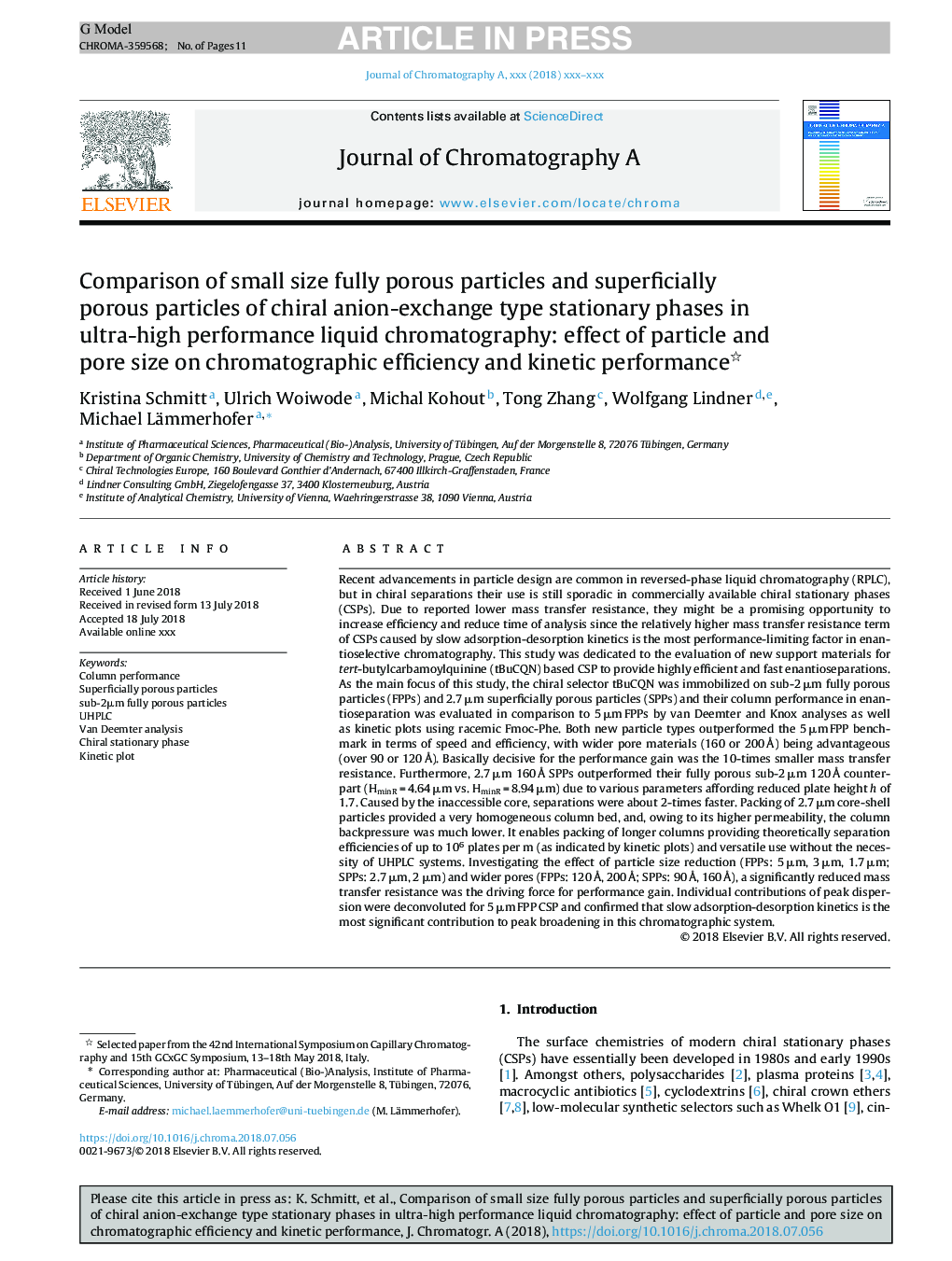| کد مقاله | کد نشریه | سال انتشار | مقاله انگلیسی | نسخه تمام متن |
|---|---|---|---|---|
| 7607317 | 1493357 | 2018 | 11 صفحه PDF | دانلود رایگان |
عنوان انگلیسی مقاله ISI
Comparison of small size fully porous particles and superficially porous particles of chiral anion-exchange type stationary phases in ultra-high performance liquid chromatography: effect of particle and pore size on chromatographic efficiency and kinetic
ترجمه فارسی عنوان
مقایسه مقادیر کوچک ذرات به طور کامل متخلخل و ذرات سطحی متخلخل فاز ثابت فاز آبی تبخیری در کروماتوگرافی مایع فوق العاده با کارایی بالا: اثر اندازه ذرات و منافذ بر کارایی کروماتوگرافی و جنبشی
دانلود مقاله + سفارش ترجمه
دانلود مقاله ISI انگلیسی
رایگان برای ایرانیان
کلمات کلیدی
موضوعات مرتبط
مهندسی و علوم پایه
شیمی
شیمی آنالیزی یا شیمی تجزیه
چکیده انگلیسی
Recent advancements in particle design are common in reversed-phase liquid chromatography (RPLC), but in chiral separations their use is still sporadic in commercially available chiral stationary phases (CSPs). Due to reported lower mass transfer resistance, they might be a promising opportunity to increase efficiency and reduce time of analysis since the relatively higher mass transfer resistance term of CSPs caused by slow adsorption-desorption kinetics is the most performance-limiting factor in enantioselective chromatography. This study was dedicated to the evaluation of new support materials for tert-butylcarbamoylquinine (tBuCQN) based CSP to provide highly efficient and fast enantioseparations. As the main focus of this study, the chiral selector tBuCQN was immobilized on sub-2âμm fully porous particles (FPPs) and 2.7âμm superficially porous particles (SPPs) and their column performance in enantioseparation was evaluated in comparison to 5âμmâFPPs by van Deemter and Knox analyses as well as kinetic plots using racemic Fmoc-Phe. Both new particle types outperformed the 5âμmâFPP benchmark in terms of speed and efficiency, with wider pore materials (160 or 200âÃ
) being advantageous (over 90 or 120âÃ
). Basically decisive for the performance gain was the 10-times smaller mass transfer resistance. Furthermore, 2.7âμm 160âÃ
SPPs outperformed their fully porous sub-2âμm 120âÃ
counterpart (HminRâ=â4.64âμm vs. HminRâ=â8.94âμm) due to various parameters affording reduced plate height h of 1.7. Caused by the inaccessible core, separations were about 2-times faster. Packing of 2.7âμmâcore-shell particles provided a very homogeneous column bed, and, owing to its higher permeability, the column backpressure was much lower. It enables packing of longer columns providing theoretically separation efficiencies of up to 106 plates per m (as indicated by kinetic plots) and versatile use without the necessity of UHPLC systems. Investigating the effect of particle size reduction (FPPs: 5âμm, 3âμm, 1.7âμm; SPPs: 2.7âμm, 2âμm) and wider pores (FPPs: 120âÃ
, 200âÃ
; SPPs: 90âÃ
, 160âÃ
), a significantly reduced mass transfer resistance was the driving force for performance gain. Individual contributions of peak dispersion were deconvoluted for 5âμmâFPP CSP and confirmed that slow adsorption-desorption kinetics is the most significant contribution to peak broadening in this chromatographic system.
ناشر
Database: Elsevier - ScienceDirect (ساینس دایرکت)
Journal: Journal of Chromatography A - Volume 1569, 28 September 2018, Pages 149-159
Journal: Journal of Chromatography A - Volume 1569, 28 September 2018, Pages 149-159
نویسندگان
Kristina Schmitt, Ulrich Woiwode, Michal Kohout, Tong Zhang, Wolfgang Lindner, Michael Lämmerhofer,
